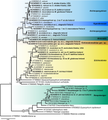Category:Media from Pantoja et al - 10.1051/parasite/2021054
Authors: Camila Pantoja, Anna Faltýnková, Katie O’Dwyer, Damien Jouet, Karl Skírnisson and Olena Kudlai
(2021). "Diversity of echinostomes (Digenea: Echinostomatidae) in their snail hosts at high latitudes". Parasite 28: 59. DOI:10.1051/parasite/2021054. ISSN 1776-1042.
| Upload media | |||||
| Instance of | |||||
|---|---|---|---|---|---|
| Main subject | |||||
| Author |
| ||||
| Published in | |||||
| Copyright license | |||||
| Publication date |
| ||||
| |||||
Abstract
The biodiversity of freshwater ecosystems globally still leaves much to be discovered, not least in the trematode parasite fauna they support. Echinostome trematode parasites have complex, multiple-host life-cycles, often involving migratory bird definitive hosts, thus leading to widespread distributions. Here, we examined the echinostome diversity in freshwater ecosystems at high latitude locations in Iceland, Finland, Ireland and Alaska (USA). We report 14 echinostome species identified morphologically and molecularly from analyses of nad1 and 28S rDNA sequence data. We found echinostomes parasitising snails of 11 species from the families Lymnaeidae, Planorbidae, Physidae and Valvatidae. The number of echinostome species in different hosts did not vary greatly and ranged from one to three species. Of these 14 trematode species, we discovered four species (Echinoparyphium sp. 1, Echinoparyphium sp. 2, Neopetasiger sp. 5, and Echinostomatidae gen. sp.) as novel in Europe; we provide descriptions for the newly recorded species and those not previously associated with DNA sequences. Two species from Iceland (Neopetasiger islandicus and Echinoparyphium sp. 2) were recorded in both Iceland and North America. All species found in Ireland are new records for this country. Via an integrative taxonomic approach taken, both morphological and molecular data are provided for comparison with future studies to elucidate many of the unknown parasite life cycles and transmission routes. Our reports of species distributions spanning Europe and North America highlight the need for parasite biodiversity assessments across large geographical areas.
Media in category "Media from Pantoja et al - 10.1051/parasite/2021054"
The following 9 files are in this category, out of 9 total.









